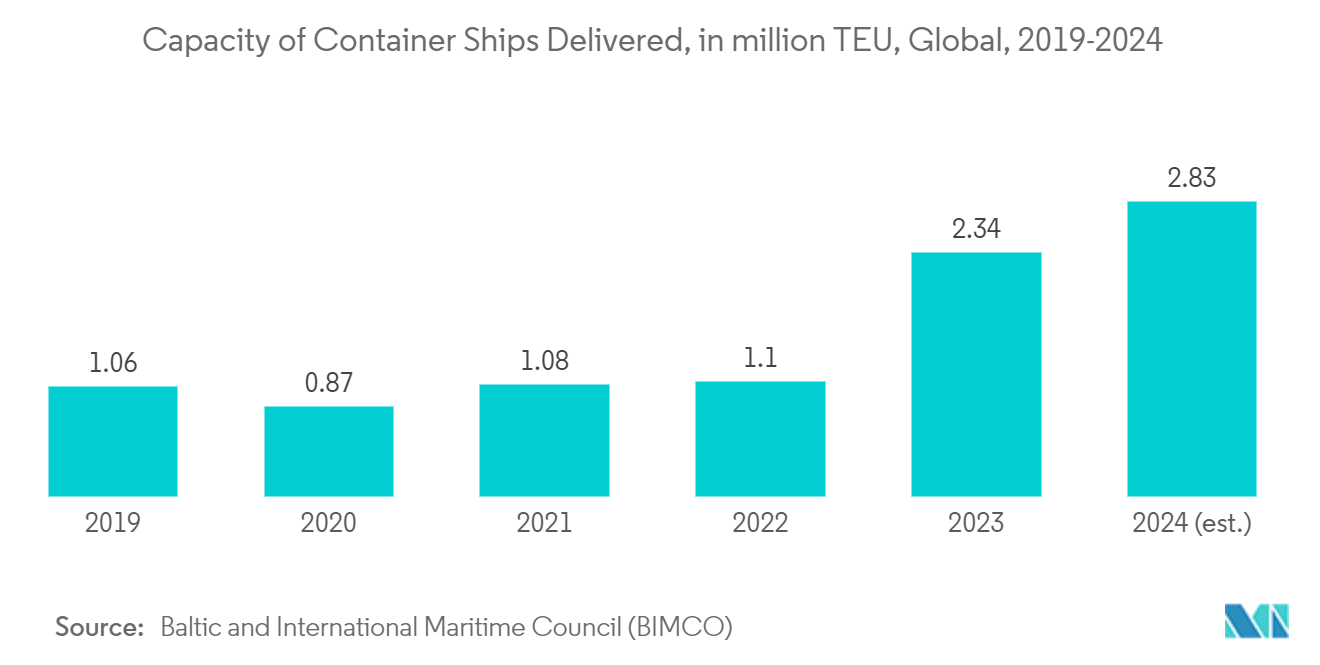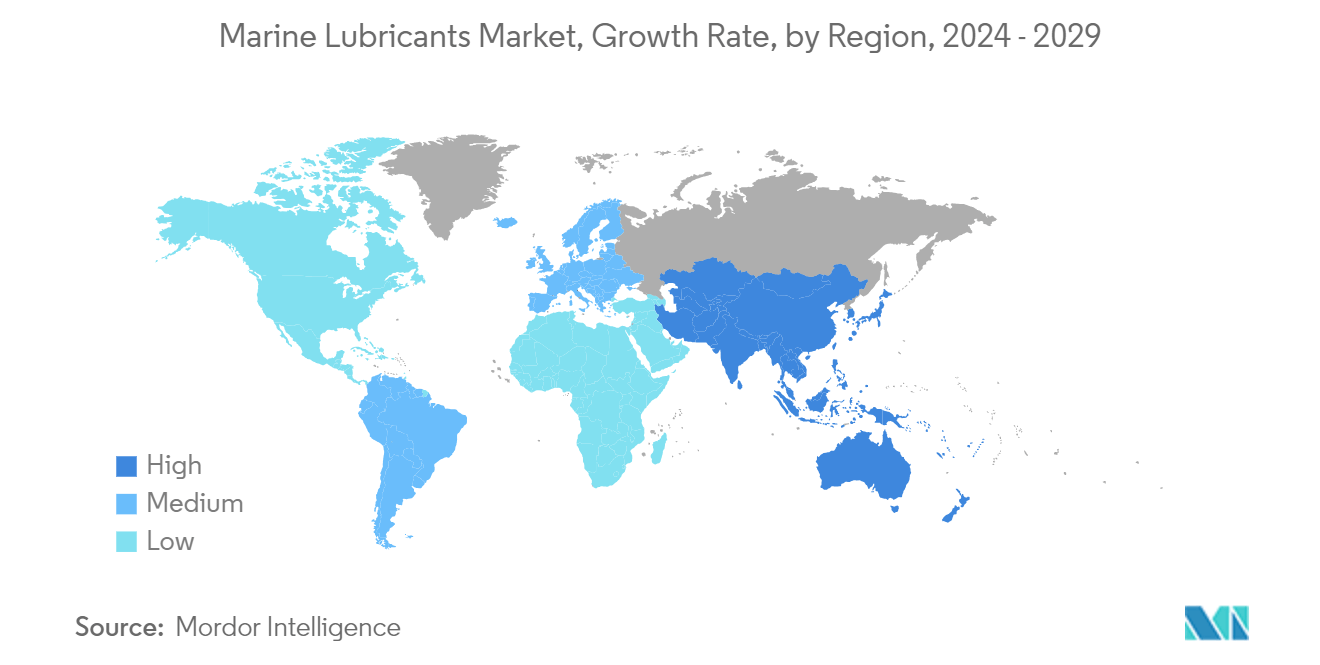Market Trends of Marine Lubricants Industry
Marine Cylinder Lubricant Segment is Expected to Dominate the Market
- Marine cylinder lubricants are essential for the smooth operation of marine vessels, especially in lubricating two-stroke and four-stroke diesel engines. These lubricants are crafted to cater to the specific needs of marine engines, which endure harsh conditions, extreme temperatures, and pressures and are prone to corrosion.
- By forming a protective film on the cylinder liner, marine cylinder lubricants prevent wear and corrosion, minimizing the risk of scuffing and scoring.
- They ensure the piston rings move smoothly and reduce friction, enhancing engine efficiency and reducing fuel consumption.
- These lubricants also play a vital role in heat transfer, moving heat from the combustion chamber to the cooling system, thereby preventing engine overheating.
- Moreover, they shield engine components from corrosion, especially against seawater and acidic combustion residues.
- As environmental regulations tighten, manufacturers of marine cylinder lubricants are in a constant race to innovate. Leading companies like Shell and Castrol have proactively introduced new products in response to these regulations. For instance:
- In March 2023, Castrol unveiled its latest marine cylinder oil, Castrol Cyltech 40 XDC (eXtra Deposit Control). Tailored for LNG and methanol-fueled vessels, this innovative oil integrates with ships powered by conventional marine fuels. This strategic move is poised to elevate the demand for marine cylinder lubricants, bolstering the market studied.
- With global naval trade on the rise, the expanding merchant navy fleet is likely to drive up the consumption of marine cylinder lubricants.
- Two-stroke engines, prevalent in the merchant fleet, including oil tankers and cargo ships, are increasingly used. Data from the United Nations Conference on Trade and Development (UNCTAD) highlighted that the world fleet's carrying capacity hit 2.3 billion dead weight tons (dwt) in January 2023, marking a 70 million dwt increase from the previous year. This surge has led to heightened consumption of marine cylinder lubricants in merchant fleet engines, stimulating market demand.
- Data from Marine Flottenkommando indicates that as of January 2023, the global count of merchant ships reached 60,000 units, a 3% rise from the prior year. This uptick in merchant ships has correspondingly boosted the consumption of marine cylinder lubricants, propelling the marine lubricants market.
- Sea freight, accounting for 90% of international merchandise trade, remains the primary mode for transporting raw materials like oil and grain over vast distances.
- According to UNCTAD, in 2023, over 106,700 merchant ships were active globally, with more than 11% engaged in oil transportation.
- In 2024, a remarkable 478 container ships, boasting a combined capacity of 3.1 million TEU (twenty-foot equivalent unit), are set for delivery, surpassing 2023's figures by 41%. This surge is projected to elevate the container fleet capacity by 10%, as reported by the Baltic and International Maritime Council (BIMCO).
- Furthermore, BIMCO forecasts a significant rise in the global delivery capacity of container ships, reaching 2.83 million TEUs in 2024 from 2.34 million TEUs in 2023.
- Given these dynamics, the marine lubricants market is expected to grow in the coming years.

Asia-Pacific is Expected to Dominate the Market
- Asia-Pacific leads the marine lubricants market, driven by a surge in imports and exports across various industries and commodities.
- The demand for essential commodities and raw materials, especially crude oil and natural gas, has increased. Aligning with the Paris Climate Pact, major developing nations in the Asia-Pacific are reducing coal consumption, transitioning to natural gas primarily for power generation and cooking. Given the region's insufficient natural gas production to meet demand, imports have become essential.
- Marine applications utilize lubricants in engine oils, air compressors, hydraulic systems, turbines, gear systems, bearings, and circulation systems.
- Data from the United Nations Conference on Trade and Development (UNCTAD) revealed in terms of deadweight tons (DWT), China, the Republic of Korea, and Japan collectively accounted for about 94% of global shipbuilding activities. Bangladesh and India were responsible for approximately 71% of global ship recycling.
- In 2023, China's shipbuilding industry, as reported by the Ministry of Industry and Information Technology (MIIT), saw completions surpassing half of the global total at 50.2%, reinforcing its dominant position in the sector.
- MIIT further reported that in 2023, China's shipbuilding completions reached 42.32 million deadweight tons (dwt), marking an 11.8% year-on-year increase. New orders surged to 71.2 million dwt, a 56.4% rise from the previous year.
- Data by the Baltic and International Maritime Council (BIMCO) underscores that Chinese shipyards have firmly established themselves as the leading builders of containerships, capturing nearly 55% of the capacity delivered in 2023 and 2024, outpacing South Korea’s 38% share. This dominance is poised to drive up demand in the marine lubricants market.
- The Union Minister of Ports, Shipping and Waterways reported that the Indian tonnage has consistently grown over the past decade. As of June 2024, 485 Indian-flagged vessels were active in Overseas Trade, totaling 11.95 million gross tonnage (GT). Additionally, 1,041 vessels with 1.7 million GT are involved in coastal trade; 4 vessels under Indian-controlled tonnage account for 45,604 GT. There are 1,530 Indian-flagged vessels with a combined 13.7 million GT. This rising Indian tonnage has shifted business preferences toward Indian-flagged vessels, suggesting a potential boost in the marine lubricants market.
- In August 2024, Hapag-Lloyd, the world's fifth-largest shipping company by fleet capacity, announced plans to invest KRW 7 trillion (~ USD 5.1 billion) in ordering large container ships. This move aims to bolster its fleet and enhance competitiveness in the global shipping arena. The company has entrusted South Korean and Chinese shipyards to construct 30 new container ships, including 15 ships ranging from 15,000 to 16,000 TEU (twenty-foot equivalent unit) and another 15 ships between 8,000 to 9,000 TEU. Such expansions present opportunities for companies like Hapag-Lloyd to grow their fleets and market share, subsequently driving up demand for marine lubricants.
- Given these dynamics, the marine lubricants market is expected to grow significantly in the coming years.


